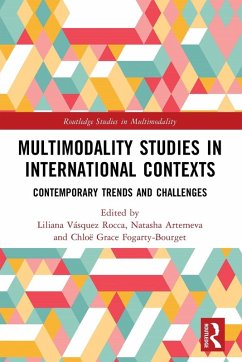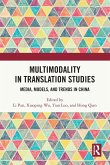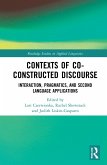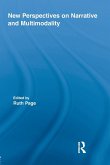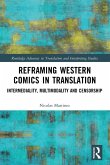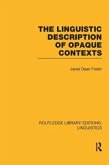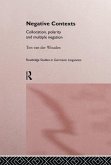Multimodality Studies in International Contexts
Contemporary Trends and Challenges
Herausgeber: Vásquez Rocca, Liliana; Fogarty-Bourget, Chloë Grace; Artemeva, Natasha
Multimodality Studies in International Contexts
Contemporary Trends and Challenges
Herausgeber: Vásquez Rocca, Liliana; Fogarty-Bourget, Chloë Grace; Artemeva, Natasha
- Broschiertes Buch
- Merkliste
- Auf die Merkliste
- Bewerten Bewerten
- Teilen
- Produkt teilen
- Produkterinnerung
- Produkterinnerung
This collection responds to the need for theoretically informed and methodologically grounded empirical research on the global transformations in multimodal human communication and social practices.
Andere Kunden interessierten sich auch für
![Multimodality in Translation Studies Multimodality in Translation Studies]() Multimodality in Translation Studies50,99 €
Multimodality in Translation Studies50,99 €![Appraisal, Sentiment and Emotion Analysis in Political Discourse Appraisal, Sentiment and Emotion Analysis in Political Discourse]() Claudia Roberta CombeiAppraisal, Sentiment and Emotion Analysis in Political Discourse57,99 €
Claudia Roberta CombeiAppraisal, Sentiment and Emotion Analysis in Political Discourse57,99 €![Contexts of Co-Constructed Discourse Contexts of Co-Constructed Discourse]() Contexts of Co-Constructed Discourse52,99 €
Contexts of Co-Constructed Discourse52,99 €![New Perspectives on Narrative and Multimodality New Perspectives on Narrative and Multimodality]() New Perspectives on Narrative and Multimodality70,99 €
New Perspectives on Narrative and Multimodality70,99 €![Reframing Western Comics in Translation Reframing Western Comics in Translation]() Nicolas MartinezReframing Western Comics in Translation57,99 €
Nicolas MartinezReframing Western Comics in Translation57,99 €![The Linguistic Description of Opaque Contexts (RLE Linguistics A The Linguistic Description of Opaque Contexts (RLE Linguistics A]() Janet Dean FodorThe Linguistic Description of Opaque Contexts (RLE Linguistics A60,99 €
Janet Dean FodorThe Linguistic Description of Opaque Contexts (RLE Linguistics A60,99 €![Negative Contexts Negative Contexts]() Ton van der WoudenNegative Contexts67,99 €
Ton van der WoudenNegative Contexts67,99 €-
-
-
This collection responds to the need for theoretically informed and methodologically grounded empirical research on the global transformations in multimodal human communication and social practices.
Produktdetails
- Produktdetails
- Verlag: Routledge
- Seitenzahl: 316
- Erscheinungstermin: 6. Mai 2025
- Englisch
- Abmessung: 229mm x 152mm x 17mm
- Gewicht: 460g
- ISBN-13: 9781032434896
- ISBN-10: 1032434899
- Artikelnr.: 73728739
- Herstellerkennzeichnung
- Libri GmbH
- Europaallee 1
- 36244 Bad Hersfeld
- gpsr@libri.de
- Verlag: Routledge
- Seitenzahl: 316
- Erscheinungstermin: 6. Mai 2025
- Englisch
- Abmessung: 229mm x 152mm x 17mm
- Gewicht: 460g
- ISBN-13: 9781032434896
- ISBN-10: 1032434899
- Artikelnr.: 73728739
- Herstellerkennzeichnung
- Libri GmbH
- Europaallee 1
- 36244 Bad Hersfeld
- gpsr@libri.de
Liliana Vásquez Rocca, PhD, is Assistant Professor in the Department of Humanities, Faculty of Education and Social Sciences, Universidad Andrés Bello, Chile. In 2018-2022, she coordinated Red Latinoamericana de Estudios sobre Multimodalidad (REDLEM, or the Latin American Network of Studies on Multimodality). She specializes in multimodality and media discourse analysis. Natasha Artemeva, PhD, is Professor, School of Linguistics and Language Studies, Carleton University, Canada. She specializes in Genre Studies, theories of learning, and multimodality. She co-edited Writing in Knowledge Societies (Parlor Press) and Genre Studies around the Globe (Inkshed), and co-authored Reconsidering Context in Language Assessment (Routledge). Chloë Grace Fogarty-Bourget holds a PhD in Applied Linguistics and Discourse Studies from the School of Linguistics and Language Studies, Carleton University, Canada, where she teaches courses in Writing and Discourse Studies. She specializes in Multimodal Discourse Analysis, Writing and Genre Studies, and the scholarship of university teaching.
Lists of Figures
List of Contributors
List of Tables
Foreword
Teresa Oteíza
Acknowledgements
Introduction
Natasha Artemeva, Liliana Vásquez Rocca, and Chloë Grace Fogarty-Bourget
PART I
Current Trends in Multimodality Studies
Chapter 1. Theoretical and Methodological Perspectives on Multimodality in
South Africa
Arlene Archer
Chapter 2. The Seeds and Growth of Multimodality in Latin America: A
Historical Review
Dominique Manghi, Carolina Badillo, and Danielle Almeida
Chapter 3. Consolidation of Multimodality Studies in Latin America: A
Review of Emergent Themes
Carolina Pérez-Arredondo and Camila Cárdenas-Neira
Chapter 4. PanMeMic. Changes in Communication and Interaction During the
COVID-19 Pandemic and Beyond: Insights from a Collective, Multimodal
Research Method
Ana Pedrazzini, Clarice Gualberto, Styliani Karatza, Maryam S. Ghiasian,
and Elisabetta Adami
PART II
Challenges to Multimodality Research in Educational Contexts
Chapter 5. Combining Multimodal Techniques to Approach the Study of
Academic Lectures: A Methodological Reflection
Edgar Bernad-Mechó
Chapter 6. A Toolkit for the Analysis of Modal Intensity: Strategies
Instructors Use to Facilitate Student Engagement in Learning
Chloë Grace Fogarty-Bourget, Jesse Pirini, and Natasha Artemeva
Chapter 7. A Multimodal Analysis of an Integrating Content and Language in
Higher Education (ICLHE) Lecture: Multimodal Ensembles in Action
Miguel F. Ruiz-Garrido and Inmaculada Fortanet-Gómez
Chapter 8. Textbook and Learning
Germán Canale
PART III
Challenges to Multimodality Studies of Social Interaction
Chapter 9. Once Upon a Time: Toy Stories, Affordances, and the Playing
Activity
Danielle Almeida and Jonathan Feitosa Ferreira
Chapter 10. Chilean Movement for Non-sexist Education and Semiosis in
Social Media: Students Advance, and Teachers Wake Up
Liliana Vásquez Rocca, Dominique Manghi, Felipe Pereira, Tomás Farías, and
Katherine Malhue
Chapter 11. Conflict in Interaction: Diverging Topic Trajectories and
Misalignment
Jarret G. Geenen and Austin Howard
Chapter 12. Peer Review and Hidden Modalities of Research Process Genres
Brad Mehlenbacher and Ashley Rose Mehlenbacher
PART IV
Conclusion
Chapter 13. Multimodal Body Work: Research in the Built Environment
Christine Räisänen
Index
List of Contributors
List of Tables
Foreword
Teresa Oteíza
Acknowledgements
Introduction
Natasha Artemeva, Liliana Vásquez Rocca, and Chloë Grace Fogarty-Bourget
PART I
Current Trends in Multimodality Studies
Chapter 1. Theoretical and Methodological Perspectives on Multimodality in
South Africa
Arlene Archer
Chapter 2. The Seeds and Growth of Multimodality in Latin America: A
Historical Review
Dominique Manghi, Carolina Badillo, and Danielle Almeida
Chapter 3. Consolidation of Multimodality Studies in Latin America: A
Review of Emergent Themes
Carolina Pérez-Arredondo and Camila Cárdenas-Neira
Chapter 4. PanMeMic. Changes in Communication and Interaction During the
COVID-19 Pandemic and Beyond: Insights from a Collective, Multimodal
Research Method
Ana Pedrazzini, Clarice Gualberto, Styliani Karatza, Maryam S. Ghiasian,
and Elisabetta Adami
PART II
Challenges to Multimodality Research in Educational Contexts
Chapter 5. Combining Multimodal Techniques to Approach the Study of
Academic Lectures: A Methodological Reflection
Edgar Bernad-Mechó
Chapter 6. A Toolkit for the Analysis of Modal Intensity: Strategies
Instructors Use to Facilitate Student Engagement in Learning
Chloë Grace Fogarty-Bourget, Jesse Pirini, and Natasha Artemeva
Chapter 7. A Multimodal Analysis of an Integrating Content and Language in
Higher Education (ICLHE) Lecture: Multimodal Ensembles in Action
Miguel F. Ruiz-Garrido and Inmaculada Fortanet-Gómez
Chapter 8. Textbook and Learning
Germán Canale
PART III
Challenges to Multimodality Studies of Social Interaction
Chapter 9. Once Upon a Time: Toy Stories, Affordances, and the Playing
Activity
Danielle Almeida and Jonathan Feitosa Ferreira
Chapter 10. Chilean Movement for Non-sexist Education and Semiosis in
Social Media: Students Advance, and Teachers Wake Up
Liliana Vásquez Rocca, Dominique Manghi, Felipe Pereira, Tomás Farías, and
Katherine Malhue
Chapter 11. Conflict in Interaction: Diverging Topic Trajectories and
Misalignment
Jarret G. Geenen and Austin Howard
Chapter 12. Peer Review and Hidden Modalities of Research Process Genres
Brad Mehlenbacher and Ashley Rose Mehlenbacher
PART IV
Conclusion
Chapter 13. Multimodal Body Work: Research in the Built Environment
Christine Räisänen
Index
Lists of Figures
List of Contributors
List of Tables
Foreword
Teresa Oteíza
Acknowledgements
Introduction
Natasha Artemeva, Liliana Vásquez Rocca, and Chloë Grace Fogarty-Bourget
PART I
Current Trends in Multimodality Studies
Chapter 1. Theoretical and Methodological Perspectives on Multimodality in
South Africa
Arlene Archer
Chapter 2. The Seeds and Growth of Multimodality in Latin America: A
Historical Review
Dominique Manghi, Carolina Badillo, and Danielle Almeida
Chapter 3. Consolidation of Multimodality Studies in Latin America: A
Review of Emergent Themes
Carolina Pérez-Arredondo and Camila Cárdenas-Neira
Chapter 4. PanMeMic. Changes in Communication and Interaction During the
COVID-19 Pandemic and Beyond: Insights from a Collective, Multimodal
Research Method
Ana Pedrazzini, Clarice Gualberto, Styliani Karatza, Maryam S. Ghiasian,
and Elisabetta Adami
PART II
Challenges to Multimodality Research in Educational Contexts
Chapter 5. Combining Multimodal Techniques to Approach the Study of
Academic Lectures: A Methodological Reflection
Edgar Bernad-Mechó
Chapter 6. A Toolkit for the Analysis of Modal Intensity: Strategies
Instructors Use to Facilitate Student Engagement in Learning
Chloë Grace Fogarty-Bourget, Jesse Pirini, and Natasha Artemeva
Chapter 7. A Multimodal Analysis of an Integrating Content and Language in
Higher Education (ICLHE) Lecture: Multimodal Ensembles in Action
Miguel F. Ruiz-Garrido and Inmaculada Fortanet-Gómez
Chapter 8. Textbook and Learning
Germán Canale
PART III
Challenges to Multimodality Studies of Social Interaction
Chapter 9. Once Upon a Time: Toy Stories, Affordances, and the Playing
Activity
Danielle Almeida and Jonathan Feitosa Ferreira
Chapter 10. Chilean Movement for Non-sexist Education and Semiosis in
Social Media: Students Advance, and Teachers Wake Up
Liliana Vásquez Rocca, Dominique Manghi, Felipe Pereira, Tomás Farías, and
Katherine Malhue
Chapter 11. Conflict in Interaction: Diverging Topic Trajectories and
Misalignment
Jarret G. Geenen and Austin Howard
Chapter 12. Peer Review and Hidden Modalities of Research Process Genres
Brad Mehlenbacher and Ashley Rose Mehlenbacher
PART IV
Conclusion
Chapter 13. Multimodal Body Work: Research in the Built Environment
Christine Räisänen
Index
List of Contributors
List of Tables
Foreword
Teresa Oteíza
Acknowledgements
Introduction
Natasha Artemeva, Liliana Vásquez Rocca, and Chloë Grace Fogarty-Bourget
PART I
Current Trends in Multimodality Studies
Chapter 1. Theoretical and Methodological Perspectives on Multimodality in
South Africa
Arlene Archer
Chapter 2. The Seeds and Growth of Multimodality in Latin America: A
Historical Review
Dominique Manghi, Carolina Badillo, and Danielle Almeida
Chapter 3. Consolidation of Multimodality Studies in Latin America: A
Review of Emergent Themes
Carolina Pérez-Arredondo and Camila Cárdenas-Neira
Chapter 4. PanMeMic. Changes in Communication and Interaction During the
COVID-19 Pandemic and Beyond: Insights from a Collective, Multimodal
Research Method
Ana Pedrazzini, Clarice Gualberto, Styliani Karatza, Maryam S. Ghiasian,
and Elisabetta Adami
PART II
Challenges to Multimodality Research in Educational Contexts
Chapter 5. Combining Multimodal Techniques to Approach the Study of
Academic Lectures: A Methodological Reflection
Edgar Bernad-Mechó
Chapter 6. A Toolkit for the Analysis of Modal Intensity: Strategies
Instructors Use to Facilitate Student Engagement in Learning
Chloë Grace Fogarty-Bourget, Jesse Pirini, and Natasha Artemeva
Chapter 7. A Multimodal Analysis of an Integrating Content and Language in
Higher Education (ICLHE) Lecture: Multimodal Ensembles in Action
Miguel F. Ruiz-Garrido and Inmaculada Fortanet-Gómez
Chapter 8. Textbook and Learning
Germán Canale
PART III
Challenges to Multimodality Studies of Social Interaction
Chapter 9. Once Upon a Time: Toy Stories, Affordances, and the Playing
Activity
Danielle Almeida and Jonathan Feitosa Ferreira
Chapter 10. Chilean Movement for Non-sexist Education and Semiosis in
Social Media: Students Advance, and Teachers Wake Up
Liliana Vásquez Rocca, Dominique Manghi, Felipe Pereira, Tomás Farías, and
Katherine Malhue
Chapter 11. Conflict in Interaction: Diverging Topic Trajectories and
Misalignment
Jarret G. Geenen and Austin Howard
Chapter 12. Peer Review and Hidden Modalities of Research Process Genres
Brad Mehlenbacher and Ashley Rose Mehlenbacher
PART IV
Conclusion
Chapter 13. Multimodal Body Work: Research in the Built Environment
Christine Räisänen
Index

